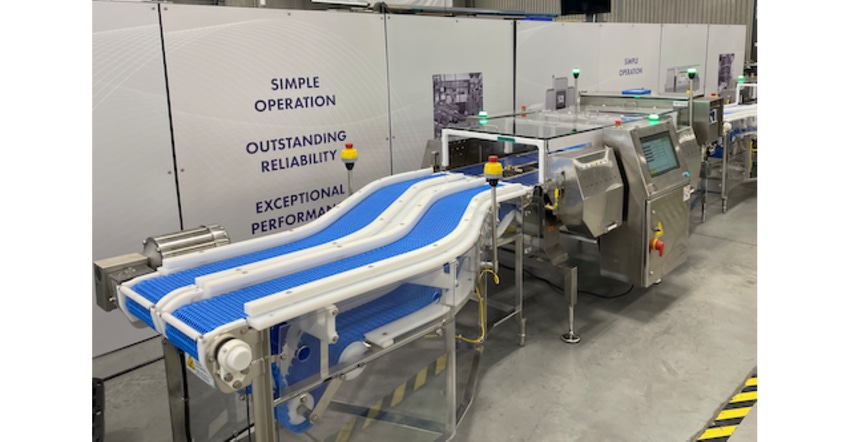Fortress Launches Ergonomic Slimline Raptor Checkweigher
The Raptor Checkweigher software provides instant adherence to local legislative weight regulations.

Fortress Technology has launched a slimline Raptor checkweigher design that prioritizes operator ergonomics.
The Raptor weight sensors reset rapidly, allowing for instant and precise weight checks of individual packs in real-time. Defined tolerance tables are also integrated into the Raptor Checkweigher software, which provides instant adherence to the local legislative weight regulations.
Here, Fortress shares Compliance Essentials that can protect brand integrity while simultaneously lowering operational costs.
Efficient weight control and checkweighing systems are integral to meeting consumer expectations. In addition to inspecting under- and overweight packages and ensuring compliance with net content regulations, deploying smart checkweighers inline and at the end of food processing lines can provide additional quality assurance, waste reduction, and brand protection.
Giving away product is the long-accepted outcome of observing weight legislation rules. However, when food manufacturers overfill packaging to avoid falling foul of international and domestic weight legislations, it can lead to a considerable loss of profit. Even nominal overfilling can add up. In a new whitepaper published by Fortress Technology, Raptor Checkweigher Product Manager Matthew Gidman examines the risks versus regulations and delves into the pitfalls of non-conformance.
Cost of Cutting Corners
Global weight regulations are in place to protect consumers against short measures. Getting caught selling underweight packaged food products can lead to penalty fines ranging from several hundred to thousands of dollars. In regions where the rules are even more strict, knowingly distributing underweight products could be deemed fraud.
The outcome could be even worse for a multi-national food company with global reach. A widespread recall could rise to several million dollars for an entire batch of underweight processed and packaged products.
Stricter Rules & Regulations
To avoid issues with weight legislation it is common practice for food plants to overfill. Yet, given the cost of ingredients, food commodities, and packaging — combined with the current cost of living crisis — overfilling is no longer considered a good or sustainable business practice.
In order to cut down on product waste and lost profits, it is advisable for food processors to familiarize themselves with the weight legislation requirements for any region where their products are sold or exported to. The rules in Canada, US, and Europe seem quite aligned although subtle differences do exist.
Typically, most global weight regulations follow three general rules:
The average weight of a product batch must not be below the nominal label weight on the package.
The percentage of packages that fall below the nominal weight should typically not exceed 2.5%. These are called the limits of error (LOE) in Canada, maximum allowable variation (MAV) in the US, and tolerable negative error (TNE) in Europe.
No individual package can have a weight that falls outside the nominal quantity by more than twice the domestically defined tolerance table.
Tolerance tables can be difficult to navigate. Manually determining and programming the correct checkweighing tolerance for specific product applications and pack sizes can be a tedious and confusing process, which can be prone to human error.
To help processors accommodate numerous weight check product variations, Fortress integrates these defined tolerance tables into its Raptor Checkweigher software, providing instant adherence to the local legislative weight regulations.
Optimizing Checkweighing Efficiency
It is widely regarded that weight checking every product on processing lines is good manufacturing practice. Fortress engineered digital signal processing into the Raptor Checkweighing series to enable the weight sensors to reset rapidly, allowing for instant and precise weight checks of individual packs in real-time. Trend feedback signals can then be instantly fed upstream to filling, portioning and, packing automation equipment, signaling when to increase or decrease fill quantity.
Another benefit of automated checkweighing is the utilization of automated reporting and data tools. Besides reducing false rejects and product waste, the use of modern network technologies allows for automatic data transmission. With integrated data collection software, everything from trends, pack rates, and live OEE data is instantly reported. Production and QA personnel can then utilize this trend feedback to monitor and fine-tune production line performance, even prior to the weight check process.
For example, if a meat manufacturer finds inconsistencies in the size of meatballs, this indicates that the processing machinery is not running accurately. Beyond highlighting this fault, precision checkweighing systems can provide a controlled feedback signal to upstream automation equipment used to portion food products. This signal specifies when to increase or decrease the fill quantity accordingly, eliminating the need for human intervention.
Staying on Trend
Inline checkweighers can be used to maintain batch-to-batch consistency. Widely used on commercial bakery lines, inline weighing will inevitably become more commonplace.
Free-from products typically use expensive ingredients in the manufacturing process; some costing two to three times more than conventional flour products. Additionally, the FDA declared in 2014 that a product carrying the label “gluten-free” must contain less than 20 parts per million or less of gluten. This places even greater regulatory pressure on producers to adhere to weight specifications.
Adapting to Fluctuating Costs
Although automated checkweighing is not as tightly regulated currently as HACCP inspection equipment, many processors now recognize the essential role these systems play in the wider quality control program. Particularly in the sectors where food ingredient costs increased in 2022, placing even greater pressure on processors to curtail product giveaway.
“A checkweigher should not just be regarded as a regulatory necessity. Although these machines are integral to meeting consumer expectations, checkweighers play an equally critical role in prioritizing food safety and reducing giveaway. It is always good practice to regularly revisit operational processes and practices and examine all food waste risks," said Gidman.
The standard Raptor checkweigher is available in four belt widths — 100mm, 200mm, 300mm and 400mm — and can verify the weight of products up to 17 lb. For bulk applications, e.g. pet food, ingredients, grains and other large items, the Raptor BBK can weigh up to 55 lb., with a heavy duty version available up to 110 lb. The Raptor Checkweigher also can be integrated with a metal detector.
About the Author(s)
You May Also Like




